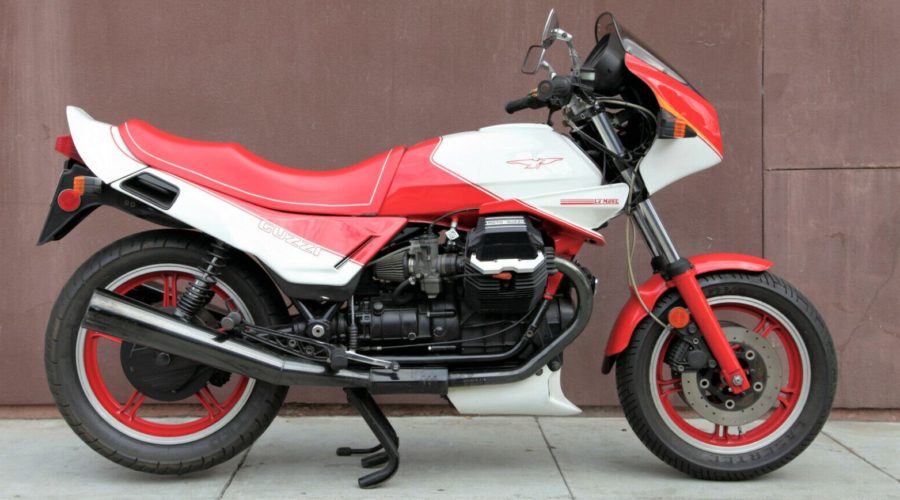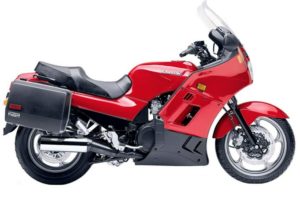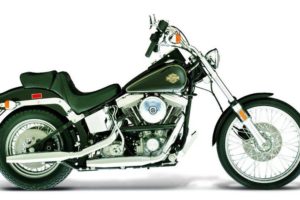1987 Moto Guzzi 1000 Le Mans
A run of the mill bike the Moto Guzzi 1000 Le Mans definitely is not. In fact, as Harleys, Ducatis and BMWs get more refined, reliable and sophisticated – more “Japanese” if you like – the Le Mans is shifted more and more outside the mainstream towards the status of a crude if charismatic symbol of a time when bikes were much more individualistic and demanding than is the case today.
If a Japanese factory was ever to build a bike like the Le Mans, it would be the target of some very cutting jokes, and roadtesters everywhere would be searching their Thesauruses in an effort to put together some original and witty abuse.
The 1000 Le Mans has actually copped plenty of this already, and it’s because Moto Guzzi made the error of trying a bit of Japanese-style tarting-up on the 850 Mklll when it grew to the 1000 MkIV in 1985.
The 16-inch front wheel was decried not only as a concession to fashion, it also robbed the Le Mans of one of its most significant attributes – excellent stability at speed.

Horror stories of 1000 Le Mans owners being thrown down the road after tankslappers on rough patches started floating around, and when Jeff Fereday tested the ’85 model back in September of that year, his comments about the bike’s steering and front end performance weren’t complimentary.
We took the next model up north in October ’86, in company with a K100RS BMW and a 1000 Hailwood Replica, and while it got out of shape a few times, modifications such as wider than standard Tingate clip-ons at least made it easier to hang on to. Still, the overriding conclusion at the end of the comparison was that the 1000 Le Mans owner would spend lots of time practicing and learning to overcome the bike’s quirks before he’d be able to really get down to enjoying his machine at speed.
For ’87, Moto Guzzi still refused to admit its mistake and get rid of the small front wheel, preferring instead to make a few changes aimed at minimising its detrimental effect on the bike’s steering and handling.

Pirelli MP7R tyres have been fitted, replacing the Michelin A and M 48s, and this is a good move because the Pirellis have gained a deserved reputation for improving a bike’s tracking and stability, both in a straight line and through corners, and the latest model is far better off than its predecessors in this area partly due to this change of rubber. The test bike wore a non-standard Dunlop K700 (130/80) on the rear, and although this was fine in combination with the MP7R front (120/80), it’s fair to say that a matched pair of Pirellis would improve things even more.
Changes have also been made to the forks, however they still incorporate Moto Guzzi’s unique arrangement of a sealed damper unit mounted atop a single rate spring with a spacer then a dual rate spring underneath that.
This year the Cebac dampers have been replaced by Bitubo units of higher volume which are claimed to offer lighter compression damping. While they are an improvement, the ride is still very harsh compared to most until you reach 120 km/h, when the suspension starts to work properly.

The unfortunate thing is that you can’t adjust the damping, even by changing the grade of fork oil, because the damper is sealed. The only oil the forks themselves carry is 150 cc of ATF for lubrication purposes.
Air caps are no longer provided (they weren’t needed in the first place) while alloy triple clamps are now fitted as well.
Another attempt to improve stability has seen the forks given slightly more offset than last years’, increasing the wheelbase.
Overall, these measures have helped to improve the stability and roadholding of the Le Mans front end on smooth, fast roads but if you’re going to ride quickly with any confidence at all on less than A1 surfaces you must resort to the steering damper, a hydraulic unit, adjustable by hand and mounted on the right of the machine.
Apart from the brief period I spent commuting on the Le Mans, when the damper was wound right off, I had it adjusted at close to maximum. I just didn’t trust the bike’s ability to keep it together in the rough otherwise.

As a consequence, the bike steered like a truck, needing plenty of pushing and shoving to change direction in a hurry and providing very little feedback, but at least it didn’t display any severe front-end nervousness, and once accustomed to it was possible to enjoy the ride and start thinking about other aspects of the bike.
The 948.8 cm3 90 degree pushrod V-twin remains unchanged from ’86. It’s a tough but very simple engine, air cooled and with only two valves per cylinder.
Ignition is battery coil with twin contact breaker points and centrifugal advance, the points and advance units being housed behind the right cylinder.
Two big 40 mm Dell’Orto carburettors with accelerator pumps supply the fuel, and the 61 kW (at 7400 rpm) of power and 82.7 Nm (at 6250 rpm) of torque are put to the road via a twin plate dry clutch, a five-speed gearbox and shaft drive.
It’s a beautiful engine to go touring with because it churns out reasonable power down low and plenty in the midrange, while hitting its straps in a big, noisy and surprisingly strong way around 1200 rpm short of its 7700 rpm redline.

The engine is dominated by its heavy flywheel, which prevents rapid acceleration and a good showing in roll-on comparisons from slow speeds but nevertheless endows the Le Mans with the ability to be slotted into fifth on the highway and, if you’re travelling at 110 km/h or above, left there. And once it’s spinning at 5000 rpm or more, it really makes the bike surge forward in a hurry. As far as top end power goes, the Le Mans is the pick of the twins, shading Ducati’s 1000 Hailwood Replica. Top speed is around 215 km/h.
However if you’re going to use it to good effect you’ll need to learn a few things beforehand. Firstly, the throttle has to be rolled on just so. Too slowly and nothing happens, too fast (below 4500 rpm) and the carburettors flood the cylinders and you sit there waiting for about five seconds before they clear properly.
Then there’s the torque reaction from the flywheel to deal with. This can be fun. Blip the throttle at the lights and you’re swung to the right. That’s harmless enough.
But when you’re tearing into a bend at speed backing off the throttle in a hurry is a big no-no. For a start, cornering clearance is reduced as the shaft drive drags the rear suspension back, but the trickiest problem is the torque reaction causing the Le Mans to fall into left handers if you allow the throttle to snap shut. More throttle obviously causes the reverse to happen.
Until you’re accustomed to it (like everything else on the Le Mans) it’s wise to proceed with caution, but experienced Guzzi riders can, I imagine, use this feature to good effect to alter the bike’s line and attitude mid-corner as necessary. But this inexperienced Le Mans rider preferred to make adjustments before going into corners and heading through under a steady hand.
Basically, the Guzzi requires a smooth riding style, just like the BMW twins, because it’s obviously a very similar machine.

There are a couple of other interesting foibles in this area too. The rear spring damper units – Koni P7610s – have three spring preload and four damping adjustments. While they generally work well, offering a reasonable ride considering their limited travel, and good roadholding, it’s necessary to jack the damping up to the third or fourth position to keep the heavy swingarm/shaft drive/wheel assembly properly under control. Too light on the damping and the rear end will continue to rise and fall long after it’s supposed to have settled down following a mid-corner dip in the road.
While the Konis can be excellent on lighter machines as replacement units, their relatively light damping is a bit overtaxed on a heavy bike like the Le Mans, with the result that the tri-rate springs often take over.
The other vice displayed by the Guzzi – and plenty of other machines with little front wheels and fat tyres – is that it wants to stand up if you get on the brakes in a bend. This can be fairly alarming until you learn to either get your braking over and done with beforehand or use extra body english to compensate.
The gearbox and clutch are both very good. The gearbox shifts positively with a far shorter throw than the boxes on the touring Guzzis like the TS and California, while the clutch is heavier than Japanese units but not uncomfortably so, taking up smoothly and – considering its dry, twin plate design – not too suddenly at slower speeds.
Neutral is easy to find once the gearbox is warm.
At high revs this type of clutch, together with the engine’s torque reaction, can make quick changing difficult. The heavy flywheel means that the revs don’t fall as quickly as most engines’ when you back off, and the fairly abrupt takeup of the clutch can cause the bike to lurch to the right if you feed it in at the wrong moment and open the throttle too quickly.
A good dose of throttle is also needed when shifting down at all revs to avoid rear wheel lockup.

Sorry to keep repeating this, but using the clutch and gearbox properly on the Le Mans is a matter of experience with the machine. You can’t get on it and go quickly until you’ve mastered its idiosyncrasies in many areas.
The brakes feature Guzzi’s linked system, where the left hand front brake works in unison with the rear via the foot pedal, while the right hand front brake operates independently via the hand lever. The brakes themselves feature fixed twin piston Brembo calipers with 260 mm discs.
Although it’s perhaps a bit out of place on a sportster (because for maximum feedback you really need the two front brakes working together and operated by hand), in the real world of wet roads, panic stops, etc, it’s the closest thing there is to an idiot-proof anti-lock braking system, especially when there’s a decent pair of tyres involved as well.
Use the hand and foot controls together and you stop fast, without any front end dive. The system is also very progressive, with none of the grabby on-or-off tendencies which have characterised Brembo twin disc front brakes on bikes such as BMW Ks and the bigger Dukes, which can be a pain in the neck in the front brake department at slower urban speeds. The Le Mans brakes are progressive and easy to use from walking pace up.
During the two weeks I had the Le Mans, it went from Melbourne to Sydney and back covering the Hume and plenty of Victorian backroads. As you can see from the photos, it carried a fair amount of gear on the return journey – a tent, throwovers, tankbag and a sleeping bag – and although there are few ocky strap points the long seat at least allowed all this stuff to be carried without cramping the riding position.

I found the Le Mans to be very comfortable – way in front of any Japanese sportster I’ve ridden in the last couple of years – except for a throttle which had supposedly been modified for a lighter action but which in fact was heavier than standard.
There is a friction screw fitted, but it’s too small to adjust by hand on the move, and to get it tight enough to hold made returning the throttle to its stop bloody hard as well – and as I didn’t fancy the thought of 215 kg of raging Italian V-twin charging along with a stuck throttle, I put up with the pain and backed the friction screw off.
Depending on how hard you’re going, you’ll get between 375-450 km from the Guzzi’s 24 litre tank (4 litres reserve), and I had no trouble staying on the bike for up to 400 km at a stretch. The pegs, even for a tall rider, are well positioned, and the bars aren’t too low or narrow to cause discomfort to the wrists. The seat is also reasonable, although a sheepskin would be a good idea if you’re going touring.
The front-end-mounted fairing directs the air stream below your helmet at the chest, taking some weight off the wrists and forearms at highway speeds. Riders below 5’10” may cop turbulence around the helmet though. There’s not much protection available against the rain, but at least your knees stay warm behind the cylinders.
Maintaining a 1000 Le Mans in good shape is a simple process. The bike’s points ignition and screw/locknut tappet adjusters are easily accessible, and with no fork oil to change ( except the lubricant once a year) or chain to adjust the only other regular tasks are checking the engine, transmission, shaft drive and brake fluids regularly, carburettor synchronisation and air filter cleaning.
Every 15,000 km (if you’re game to leave it that long) it’s necessary to remove the sump, replace the spin-on oil filter and wash the secondary wire gauze filter, but routine oil changes (every 3000 km) require only one drain plug (located at the rear of the sump) to be removed.

The Le Mans certainly gives the impression of strength and quality. Paintwork on the test bike was better than on the ’86 version we tested, although the fairing wasn’t very well finished, while the alloy castings, all fasteners and most other components were well made and assembled.
Problems on the test bike included the left muffler wanting to abandon ship, a clutch cable which was spotted just as it was about to snap at Yass (due to the cable guide and the clutch arm being out of alignment, causing the cable to rub on the guide), the gearbox being overfilled with oil and consequently leaking, and a slight fuel leak at the left tap. During the 2500 km I had the bike, the engine stayed oil tight (and didn’t use any significant amount) and in tune, although its performance had been slightly improved down low by the substitution of a narrow balance pipe for the large collector box between the exhausts. This also gave better access to the engine oil drain plug.
Ancilliaries are a strange mixture of the practical on the one hand and Italian design gone troppo on the other. The instruments are clear and easy to read, although the tacho doesn’t have numerals on the 60 or 100 km/h graduations. Useful are the voltmeter, the oil pressure light and the brake fluid light which monitors levels in both the master cylinders. Other panel lights include neutral, high beam, generator and – this is a beauty – a light to tell you when you’ve got your lights on…
Switches are all over the place. The lift for right turn/depress for left turn indicator switch I couldn’t ever figure out properly, although an owner would eventually, while the location of the high/low beam switch on the right means that it’s impossible to dip your lights without shutting the throttle. Weird.
The mirrors, made by Vitaloni, remain very clear and unaffected by vibration, but they don’t extend out far enough to let you see the full picture behind. The twin horns are great, as is the toolkit – you could just about do a roadside rebuild with it. The 55/60 watt headlight is average – good for 110km/h but not much more.
A handy item is the hazard light switch, which activates all four blinkers, and the Guzzi also had the first Niemann steering head lock I’ve ever used that was easy to depress and release.

The overwhelming impression I was left with after I handed the Le Mans back was that Moto Guzzi couldn’t work out what they wanted to turn the 850 into, so they ended up building a traditional European motor cycle from the steering head back, with a half-arsed example of Japanese front end fashion bolted on the front.
There were lots of things I liked about the Le Mans, and lots of things that I would come to like given time, but I can’t help thinking that the bike’s designers fell for the biggest trick in the book – putting form before function. Perhaps it’s Italian pride which causes them to persist with the 16-inch front wheel, but I’ve got a feeling that in 1988 it won’t be a big feature on the Guzzi model lineup.
By Bill McKinnon. Two Wheels, November 1987.

Classic bike expert and historian Ian Falloon has just updated his epic history of Moto Guzzi in a special edition to commemorate the marque’s 100th anniversary in 2021. “The Complete Book of Moto Guzzi. Every Model Since 1921. 100th Anniversary Edition” is now available, including a limited number of first edition, author signed copies direct from Ian. The price is $69.95, which includes postage within Australia only. Order your copy here.
Overseas buyers wish to purchase a copy should should get in touch with Ian here.





